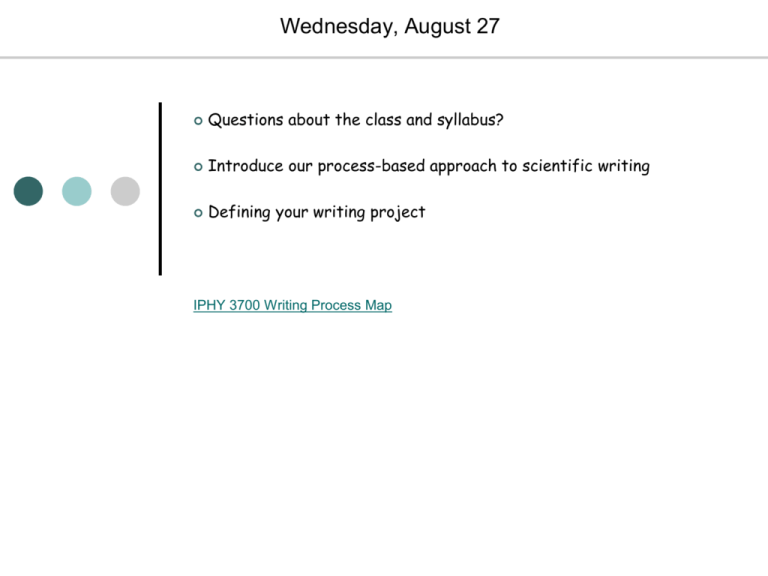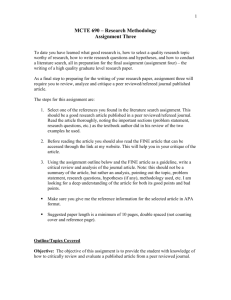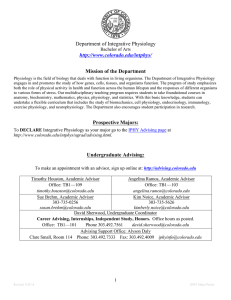defineProject
advertisement

Wednesday, August 27 Questions about the class and syllabus? Introduce our process-based approach to scientific writing Defining your writing project IPHY 3700 Writing Process Map Process Activity: Analyzing Your Writing Task Carefully attend to the assignment instructions. Make checklists and take notes on instructions and guidelines that aren’t your “defaults.” Seek clarification on ambiguous or missing instructions and guidelines. Seek feedback on your plans for applying instructions and guidelines. Carefully attend to the assignment instructions "Instructions to Authors" Documents: The American Physiological Society: Author Information and Instructions Conservation Biology Instructions to IPHY 3700 Authors Make checklists and take notes on instructions and guidelines that aren’t your “defaults” A helpful strategy is to extract from the written assignment only those instructions that you don't normally follow. If, for example, your instructions are to double-space your paper and you always do that naturally, don't sweat the detail. But if your word processor's default for line spacing is set at 1, make a note to remind yourself to change the spacing when you sit down to draft. Sample Checklists and Note Forms Seek Clarification and Feedback on Your Understanding of the Writing Task Dear Professor Amby Guious, I'm planning to write my term paper on the effects of leadcontaminated river sediment on nervous system diseases in Canadian geese. Reading over the assignment that you gave us, I'm not exactly sure if I clearly understand the instruction to "illustrate the relationship between the pollutant and a number of health outcomes in the species." For that part of my paper I'm planning to discuss how lead exposure can cause oxidative stress in the brain, which destroys brain cells and leads to several nervous system disorders and diseases. I'm interpreting your instruction to mean that we should write about the causal relationships between the pollutant and the health outcomes. Would you please let me know if my plan is on the right track for the assignment? Thank you, Justine Pierce Learn the Discourse Conventions Communication Form Main Objectives and Structural Elements Typical length (number of double-spaced pages) Research papers Report on original research, either a single study or a series of several related studies on a focused issue. Major sections are organized by the IMRAD (Introduction, Methods, Results, and Discussion) format. Review papers Summarize, synthesize, and critically evaluate the field of published 30-60 studies on a focused topic or research issue. Major sections are devoted to discussing subtopics of the overall topic or to presenting critical lines of evidence and reasoning. Request approval and funding for research projects. Major sections Up to 50 are devoted to presenting the proposed research methods, detailing the planned budget, and describing potential beneficial outcomes of the study. Systematically review previous studies on a focused research issue 10-25 by applying a special form of statistical analysis to their results. Major sections are organized by the IMRAD format. Research and grant proposals Meta-analyses Case studies 15-30 5-10 Books Report on observations or experiments involving a single individual who is suffering from a disease or disorder. Describe new instruments, procedures, and analyses for conducting research. Review and critique articles that are in the same issue of the journal. Usually structured in essay format. Journal editors invite authors to contribute these pieces. Authored by readers who comment on, review, and critique articles in recent issues of a journal. When an article is negatively criticized in a letter to the editor, the authors of the article are often given the opportunity to write letters in response. Present a broadly defined scientific topic in a full-length treatise. Book reviews Summarize and critique recently published scientific books. 1-2 Technical notes and methods papers Editorials and commentaries Letters to the editor 5-10 2-4 1-2 Hundreds Our Writing Assignment What to write: The assignment is to write what we'll call a "discussion essay" based on the methods and results of the hypothetical study reported in this document. Note that you won't write the entire discussion section of a standard research paper. Instead, you'll write selected parts of a discussion section, adapting the content and structure to meet criteria that we'll discuss in upcoming class meetings. Paper length: The maximum length for the first draft and final paper is 1600 words (not counting the reference list). To have the potential for an excellent grade, you must not exceed the maximum word count. You should, however, try to get as close to the maximum limit as possible on both your first draft and final paper. Audiences: Your audiences are (1) upper-division integrative physiology majors who are not in IPHY 3700 this semester and (2) me, your scientific writing instructor. We'll devote class time to talking about how to develop and tailor your paper's content, structure, and language through considering the needs, expectations, and values of your readers. Grading criteria: In many class meetings over the first half of the semester, I'll talk extensively about the criteria by which I'll grade final papers. Style, format, and paper submission guidelines: Guidelines for preparing and submitting papers are in the handout, "Instructions to IPHY 3700 Authors." You'll find a link to this handout in the "Everyday Stuff" menu on the course Web site.






